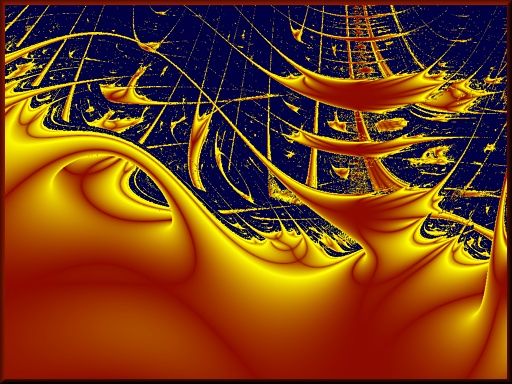Renderosity Forums / Fractals
Welcome to the Fractals Forum
Forum Moderators: Anim8dtoon, msansing
Fractals F.A.Q (Last Updated: 2024 Nov 13 3:03 pm)
Subject: Lyaponov fractals
Yes, I've seen several (although I must admit that it's been some months since I last looked), but none that produced the nice results I want. I also want a prog that can calculate large images (I'm talking about one or more square meters at the printer's resolution), not that I have the disk space and lots of spare CPU time (three fast dual processor machines that mostly idles...). I thought that someone could recommend a prog worth trying, sparing me the effort of sifting through dozens of progs that's not up to the task. /Troberg
One of the Mac freeware programs that I tried comes with a Lyapunov folder, but I'll be darned if I can recall which one...? (Of course, that doesn't guarantee that it will do them properly!) The apps are all on my old Mac, which will not talk to my new Mac until we buy a $$ piece of networking hardware....... So I'm unable to look it up for you (and fractalless, myself!!) until I can go out and download the apps again. Did you try a search using Lyapunov as a key word??
Sorry, Mac wont help me. I've invested too much money in PC hardware to change and anyway I'm a programmer so a toy like a Mac is not for me (I need a toy like a cluster of three dual processor PC's...). Of course I've tried searching, but I've yet to find one that produced good results. If you want to try it, the best prog I can recommend is an old prog called Lyaponovia for the Amiga. If you don't have an Amiga or (like me) hasn't used it in almost 10 years, there are some good emulators out there (UAE is my favourite). /Troberg

geez, get better soon!! you're welcome for the info, I like Lyapunov images and that's why I tried to find out what made them tick, so to speak. Why I couldn't zoom in like a fractal. The knowledge really isn't that impressive, just pieces and parts thrown together. (-: There's just not a lot written about the images, what they are or how and why they act as they do. At least from what I found and what I wanted to know about them.
Privacy Notice
This site uses cookies to deliver the best experience. Our own cookies make user accounts and other features possible. Third-party cookies are used to display relevant ads and to analyze how Renderosity is used. By using our site, you acknowledge that you have read and understood our Terms of Service, including our Cookie Policy and our Privacy Policy.




Let me just start by saying that I am aware that lyaponov is not a true fractal, but it pruduces very fractal-like images with very fractal-like math. If you havn't tried them yet, it's worth a try. They give very clean (uncluttered) images with a slightly disturbing fell to them. Many years ago I had a program for the Amiga that made some awesome lyaponov images (although I suspect that most of the effect was due to an effective color scheme), but has been unable to find a decent prog for this on the PC. Any suggestions? /Troberg